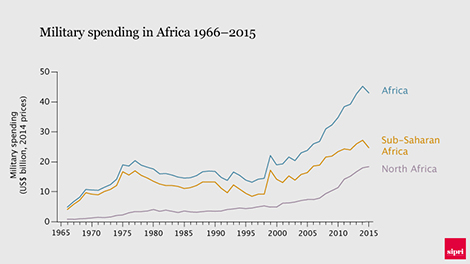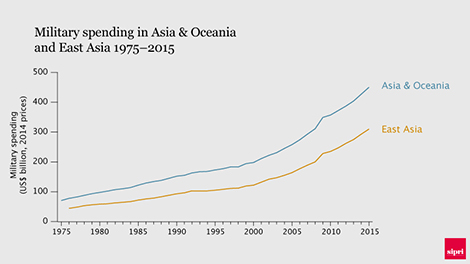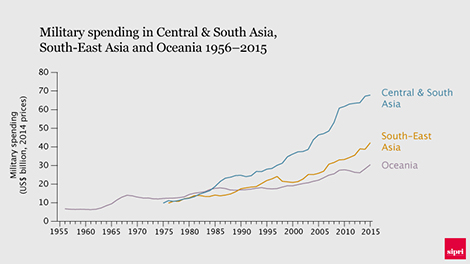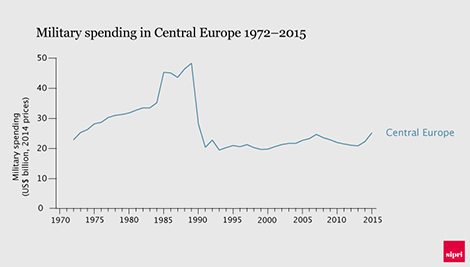
This article was originally published by the Stockholm International Peace Research Institute (SIPRI) on 21 November 2016.
Today, SIPRI is launching its new extended military expenditure data—free to download from our website—with consistent data going back as far as 1949.
It may seem curious that, although SIPRI has published military expenditure data almost since its creation, starting with data from 1950 in the very first SIPRI Yearbook of 1969/70, for the past 20 years or so we have only been able to provide data going back to 1988. Varying methodologies meant that we could not guarantee consistency between data collected before 1988 and data collected after 1988, and so no meaningful comparisons between these data sets could be made. Until now.
Regional military spending trends in the data
This blog post looks at the major regional trends in military spending that are uncovered by the new data. For definitions of regions, please see the regional coverage webpage.
Military spending in Africa increased sharply up to 1976, before falling significantly up to 1985. This trend is mostly driven by Nigeria, whose spending increased 20-fold between 1966 and 1975, from $439 million to $8970 million. The increase in the first few years is explained by the Biafra war (1967-70), but even after this finished, Nigeria’s spending continued to increase rapidly. After 1975, Nigerian spending fell sharply, so that by 1989 it was only around one seventeenth of its 1975 level in real terms. Nonetheless, military spending in most African countries for which data is available also increased up to 1976, sometimes very sharply, for example in Morocco, Kenya, South Africa and Tanzania.
Up to 1995, African spending oscillated around a fairly stable level or fell slightly, as the continent struggled under crippling debt burdens—and as the end of the cold war saw the end also of numerous proxy conflicts, while the end of Apartheid in South Africa saw their spending fall significantly. Since then, however, African military spending has surged as the continent’s economies have improved, while increasing oil resources have frequently been squandered on high military spending.

The best long-term series available are for North America and Western Europe. North American military spending—dominated overwhelmingly by the USA—shows clear peaks with the Korea War, the Vietnam war, the Reagan build-up and the post-9/11 wars and rearmament, with periods of falling spending as hot and cold wars ended, and most recently with the global economic crisis. Western European military spending increased fairly consistently over the cold war before falling sharply from 1990-95, then gradually increasing (again partly due to wars in Iraq and Afghanistan) up to 2009 before falling sharply as a result of the economic crisis.

In South America, the 1960s and 1970s—a period of military coups and sometimes sharp interstate tensions—saw rapid increases in military spending up to 1977, after which the trend became more ambiguous with fluctuating economies and international relations. Nonetheless, total regional spending generally increased slightly up to 1989. The dramatic falls up to 1992 are almost entirely due to a near halving of military spending in Brazil, plagued by hyperinflation and a debt crisis, although there were also major cuts by Argentina and Colombia.
Since then, the trend has been generally upwards, albeit with some blips, as the region’s economies have tended to strengthen. The total for Central America & the Caribbean is overwhelmingly dominated by Mexico, although civil wars in Central America in the 1980s and 1990s also had an impact. The region’s spending increased significantly up to 1984, before remaining fairly flat up to 2004. Thereafter, the drug wars have seen a sharp increase in military spending.

Military spending in Asia & Oceania, particularly the region of East Asia, is subject to considerable uncertainty up to 1988, due to the lack of data for China, but the trend is very clearly and consistently upwards through almost the entire period.
SIPRI’s military expenditure estimates for China for 1989 and onwards are based on a methodology developed by Professor Wang Shaoguang in 1999, which initially covered the period 1989-98. (See Sources and Methods). It is far from clear that this methodology would be applicable to the pre-1989 period. However, the official Chinese defence budget is available back to 1950, although it is likely that the difference between the official budget and the true level of China’s military spending was even higher in earlier years. A new study of Chinese military expenditure would be required to provide meaningful estimates.

Military spending in the sub-regions of Central & South Asia, South-East Asia and Oceania show a clear upward trend throughout the period (going back to 1956 for Oceania), most strongly for Central & South Asia, and somewhat more unevenly for Oceania. Strong economic growth throughout the region is a major driver, although periodic regional conflicts and tensions, especially between India and Pakistan and between North and South Korea, has also played a role.

Central European military spending saw a generally increasing trend during the cold war years—with a particularly sharp increase by Romania in 1985—followed by a massive fall in 1990 with the reunification of Germany and thus the end of a separate East Germany as part of the total. After another fall in 1991 as the cold war ended, the total remained relatively flat over the 1990s, before increasing as most countries in the region joined or prepared to join NATO. This ended in 2007 after which the beginnings of the global economic crisis led to sharp falls up to 2013, since when Poland has led a regional increase, driven by fears of Russia.

It has not been possible to extend the data for military spending in Eastern Europe backwards, as before 1992, ‘Eastern Europe’ consists solely of the Soviet Union, for which there is no data prior to 1988.
Soviet military spending was highly secretive, and while many western attempts were made to estimate it (including by SIPRI), all involved a high degree of uncertainty, often dubious assumptions and methodologies, and sometimes political considerations. In fact, SIPRI stopped publishing estimates of Soviet military spending in the 1980s due to the severity of the difficulties in making even somewhat reliable estimates. Any attempt to produce new and better estimates for Soviet spending before 1988 would require a major new study, and probably an analysis of now-available Soviet-era government documents.
The figures show the collapse in spending by Russia and other former Soviet States from 1992, compared to the previous level of Soviet spending, with the declines continuing until 1998 (the trend from 1992 onwards being dominated by Russia). From 1999 onwards, since Vladimir Putin became President of Russia, military spending in the region has increased substantially, led by Russia but followed by most other countries in the region. The total is still far lower, however, than spending levels by the former USSR.
Finally, military spending in the Middle East does not include Iraq due to lack of data, although an alternative series including Iraq is available from 2004. Given the importance of Iraq in the region during the Iran-Iraq war especially, this limits the usefulness of the data. Nonetheless, the figures show, after an initial increase, a gradually falling trend over the 1980s. There is a gap in 1986 when there is no data for Saudi Arabia. The first Gulf War in 1990-91 shows a very sharp increase (in 1991 Kuwait’s military spending was more than 100% of its GDP), after which the total fell back to 1995. Since then, strong oil revenues and continuing regional conflicts and tensions have seen a strongly increasing trend in military spending.
Extending SIPRI’s military spending data
Military expenditure series have been extended back to 1975 for 107 of the 140 countries that were independent at the time (96 with constant dollar data). Data has been extended back to 1960 for 69 out of 108 countries (56 for constant dollars). From 1957, a majority of countries (45 out of 89) have constant dollar data available. The regions of best data availability are Europe and the Americas. Asia and Oceania is the region with the highest proportion of countries where little or no backdating was possible, but a smaller proportion of African and Middle Eastern countries could be taken back before the mid-1960s.
The extended data set has already begun to lead to new and exciting research into the determinants and effects of military spending. Not only is it now possible for researchers to apply their analysis to longer time series of data, but the longer series also allow for the use of statistical techniques that give more robust and detailed results. Studies conducted so far include those on the impact of military expenditure on the economy, the economic, political and security factors affecting military spending, and the interrelationship between military spending and conflict. Moreover, the fact that the data series now covers much of the cold war period allows us to see how these relationships have changed, if at all, since the end of the cold war.
Acknowledgements
The extended database project was started by Dr Elisabeth Sköns who took over the military expenditure project at SIPRI in 1998. Together with her team, Elisabeth managed to extend the database back to 1988. When I took over the military expenditure database in 2009, I made a priority of extending the database backwards in time before 1988. With guest researcher Jenni Brauner, we began extending the database backwards, starting with figures for the Middle East. Over the following five years, Jenni’s work on the Middle East was followed by work by Mehmet Uye, Lidwinka Gundacker, Elena Deola, Giulia Tamagni and Julius Heß, until by mid-2015 the project was complete.
About the Author
Dr Sam Perlo-Freeman is the Head of the SIPRI Project on Military Expenditure in the Arms and Military Expenditure Programme.
For more information on issues and events that shape our world, please visit our CSS Security Watch Series or browse our Publications.

